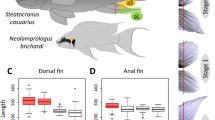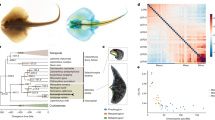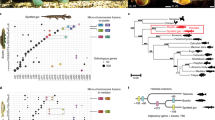Abstract
A classic textbook example of adaptive radiation under natural selection is the evolution of 14 closely related species of Darwin's finches (Fringillidae, Passeriformes), whose primary diversity lies in the size and shape of their beaks1,2,3,4,5,6. Thus, ground finches have deep and wide beaks, cactus finches have long and pointed beaks (low depth and narrower width), and warbler finches have slender and pointed beaks, reflecting differences in their respective diets6. Previous work has shown that even small differences in any of the three major dimensions (depth, width and length) of the beak have major consequences for the overall fitness of the birds3,4,5,6,7. Recently we used a candidate gene approach to explain one pathway involved in Darwin's finch beak morphogenesis8. However, this type of analysis is limited to molecules with a known association with craniofacial and/or skeletogenic development. Here we use a less constrained, complementary DNA microarray analysis of the transcripts expressed in the beak primordia to find previously unknown genes and pathways whose expression correlates with specific beak morphologies. We show that calmodulin (CaM), a molecule involved in mediating Ca2+ signalling, is expressed at higher levels in the long and pointed beaks of cactus finches than in more robust beak types of other species. We validated this observation with in situ hybridizations. When this upregulation of the CaM-dependent pathway is artificially replicated in the chick frontonasal prominence, it causes an elongation of the upper beak, recapitulating the beak morphology of the cactus finches. Our results indicate that local upregulation of the CaM-dependent pathway is likely to have been a component of the evolution of Darwin's finch species with elongated beak morphology and provide a mechanistic explanation for the independence of beak evolution along different axes. More generally, our results implicate the CaM-dependent pathway in the developmental regulation of craniofacial skeletal structures.
This is a preview of subscription content, access via your institution
Access options
Subscribe to this journal
Receive 51 print issues and online access
$199.00 per year
only $3.90 per issue
Buy this article
- Purchase on Springer Link
- Instant access to full article PDF
Prices may be subject to local taxes which are calculated during checkout




Similar content being viewed by others
References
Darwin, C. R. Journal of Researches into the geology and Natural History of the various countries visited during the voyage of H.M.S. Beagle, under the command of Captain FitzRoy, R.N. 2nd edn (John Murray, London, 1845)
Lack, D. Darwin's Finches (Cambridge Univ. Press, Cambridge, 1947)
Grant, P. R. The Ecology and Evolution of Darwin's Finches (Princeton Univ. Press, Princeton, New Jersey, 1999)
Futuyma, D. J. Evolutionary Biology 3rd edn (Sinauer Associates, Sunderland, Massachusetts, 1998)
Freeman, S. & Herron, J. C. Evolutionary Analysis 3rd edn (Prentice Hall, Englewood Cliffs, New Jersey, 2003)
Bowman, R. I. Morphological differentiation and adaptation in the Galapagos finches. Univ. Calif. Publ. Zool. 58, 1–302 (1961)
Grant, P. R. & Grant, B. R. Unpredictable evolution in a 30-year study of Darwin's finches. Science 296, 707–711 (2002)
Abzhanov, A., Protas, M., Grant, R. B., Grant, P. R. & Tabin, C. J. Bmp4 and morphological variation of beaks in Darwin's finches. Science 305, 1462–1465 (2004)
O'Day, D. H. CaMBOT: profiling and characterizing calmodulin-binding proteins. Cell. Signal. 15, 347–354 (2003)
Burke, A. C., Nelson, C. E., Morgan, B. A. & Tabin, C. Hox genes and the evolution of vertebrate axial morphology. Development 121, 333–346 (1996)
Averof, M. & Patel, N. H. Crustacean appendage evolution associated with changes in Hox gene expression. Nature 388, 682–686 (1997)
Abzhanov, A. & Kaufman, T. C. Novel regulation of the homeotic gene Scr associated with a crustacean leg-to-maxilliped appendage transformation. Development 126, 1121–1128 (1999)
Abzhanov, A. & Kaufman, T. C. Crustacean (malacostracan) Hox genes and the evolution of the arthropod trunk. Development 127, 2239–2249 (2000)
Shapiro, M. D. et al. Genetic and developmental basis of evolutionary pelvic reduction in threespine sticklebacks. Nature 428, 717–723 (2004)
Kimmel, C. B. et al. Evolution and development of facial bone morphology in threespine sticklebacks. Proc. Natl. Acad. Sci. USA 102, 5791–5796 (2005)
Grant, P. R. Inheritance of size and shape in a population of Darwin's finches. Proc. R. Soc. Lond. B 212, 403–432 (1983)
Price, T. D. & Grant, P. R. The evolution of ontogeny in Darwin's Finches: a quantitative genetics approach. Am. Nat. 125, 169–188 (1985)
Grant, B. R. & Grant, P. R. Evolutionary Dynamics of a Natural Population. The Large Cactus Finch of the Galápagos (Univ. Chicago Press, Chicago, Illinois, 1989)
Grant, P. R. & Grant, B. R. Phenotypic and genetic effects of hybridization in Darwin's finches. Evolution Int. J. Org. Evolution 48, 297–316 (1994)
Kirschner, M. W. & Gerhart, J. C. The Plausibility of Life: Resolving Darwin's Dilemma (Yale Univ. Press, New Haven, Connecticut, 2005)
Hamburger, V. & Hamilton, H. L. A series of normal stages in the development of the chick embryo. J. Morphol. 88, 49–92 (1951)
Dudoit, S., Yang, H., Callow, M. J. & Speed, T. P. Statistical methods for identifying genes with differential expression in replicated cDNA experiments. Statist. Sin. 12, 111–139 (2002)
Petren, K., Grant, B. R. & Grant, P. R. A phylogeny of Darwin's finches based on microsatellite DNA length variation. Proc. R. Soc. Lond. B 266, 321–329 (1999)
Acknowledgements
We thank all field assistants and participants of the field collecting trips—M. Protas, J. Chavez, G. Castaneda, O. Perez, F. Brown, A. Aitkhozhina, M. Gavilanes, M. Paez, K. Petren, J. Podos and S. Kleindorfer—for their advice with species identification and other advice; Charles Darwin Research Station on Santa Cruz Island and The Galápagos National Park for permits and logistical support; and M. Kirschner for discussions that led to the inception of this project. A.A. was supported by the Cancer Research Fund of a Damon Runyon–Walter Winchell Foundation Fellowship. This project was funded by a program project grant from the NIH to C.J.T. Author Contributions A.A. performed embryonic material collection, microarray probe preparation, microarray hybridizations and scanning, sectioning of material, in situ hybridizations and CaMKII functional analysis in chicken embryos. W.P.K. conducted all relevant bioinformatics analyses. C.H. constructed the RCAS virus carrying the constitutively active version of CaMKII. B.R.G. and P.R.G. provided logistics and secured permits for the fieldwork on the Galápagos Islands. C.J.T. conceived and supervised the project. A.A., B.R.G., P.R.G. and C.J.T. co-wrote the manuscript. All authors discussed the results and commented on the manuscript.
Author information
Authors and Affiliations
Corresponding author
Ethics declarations
Competing interests
The sequence of Darwin's finch CaM has been deposited at GenBank under accession number DQ386479, and the microarray data have been filed with ArrayExpress under the accession number E-MEXP-702. Reprints and permission information is available at npg.nature.com/reprintsandpermissions. The authors declare no competing financial interests.
Supplementary information
Supplementary Information Material
This file contains Supplementary Figures (PDF 3051 kb)
Rights and permissions
About this article
Cite this article
Abzhanov, A., Kuo, W., Hartmann, C. et al. The calmodulin pathway and evolution of elongated beak morphology in Darwin's finches. Nature 442, 563–567 (2006). https://doi.org/10.1038/nature04843
Received:
Accepted:
Issue Date:
DOI: https://doi.org/10.1038/nature04843
This article is cited by
-
Recent beak evolution in North American starlings after invasion
Scientific Reports (2024)
-
Genetic mapping of craniofacial traits in the Mexican tetra reveals loci associated with bite differences between cave and surface fish
BMC Ecology and Evolution (2023)
-
Molecular mechanisms of adaptive evolution in wild animals and plants
Science China Life Sciences (2023)
-
Evolvability and Macroevolution: Overview and Synthesis
Evolutionary Biology (2022)
-
Unveiling the third dimension in morphometry with automated quantitative volumetric computations
Scientific Reports (2021)
Comments
By submitting a comment you agree to abide by our Terms and Community Guidelines. If you find something abusive or that does not comply with our terms or guidelines please flag it as inappropriate.



